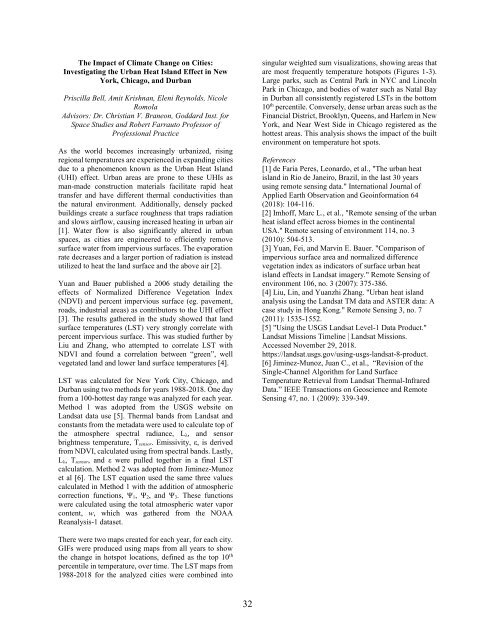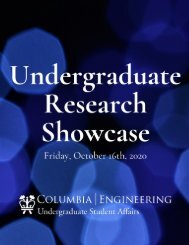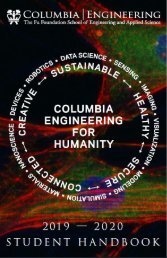Senior Design Expo 2019
The Senior Design Expo, held annually in May at Columbia University, is an opportunity for Columbia Engineering students to showcase what they have learned in their foundational math and science courses together with their engineering courses in innovative, creative, and purposeful designs and prototypes. Each year the Expo showcases more than 60 projects across all nine departments. Projects have included cutting-edge robotics, the New York City subway system, language technology, proposals for bridges to span the Hudson river, and much more.
The Senior Design Expo, held annually in May at Columbia University, is an opportunity for Columbia Engineering students to showcase what they have learned in their foundational math and science courses together with their engineering courses in innovative, creative, and purposeful designs and prototypes. Each year the Expo showcases more than 60 projects across all nine departments. Projects have included cutting-edge robotics, the New York City subway system, language technology, proposals for bridges to span the Hudson river, and much more.
Create successful ePaper yourself
Turn your PDF publications into a flip-book with our unique Google optimized e-Paper software.
The Impact of Climate Change on Cities:<br />
Investigating the Urban Heat Island Effect in New<br />
York, Chicago, and Durban<br />
Priscilla Bell, Amit Krishnan, Eleni Reynolds, Nicole<br />
Romola<br />
Advisors: Dr. Christian V. Braneon, Goddard Inst. for<br />
Space Studies and Robert Farrauto Professor of<br />
Professional Practice<br />
As the world becomes increasingly urbanized, rising<br />
regional temperatures are experienced in expanding cities<br />
due to a phenomenon known as the Urban Heat Island<br />
(UHI) effect. Urban areas are prone to these UHIs as<br />
man-made construction materials facilitate rapid heat<br />
transfer and have different thermal conductivities than<br />
the natural environment. Additionally, densely packed<br />
buildings create a surface roughness that traps radiation<br />
and slows airflow, causing increased heating in urban air<br />
[1]. Water flow is also significantly altered in urban<br />
spaces, as cities are engineered to efficiently remove<br />
surface water from impervious surfaces. The evaporation<br />
rate decreases and a larger portion of radiation is instead<br />
utilized to heat the land surface and the above air [2].<br />
Yuan and Bauer published a 2006 study detailing the<br />
effects of Normalized Difference Vegetation Index<br />
(NDVI) and percent impervious surface (eg. pavement,<br />
roads, industrial areas) as contributors to the UHI effect<br />
[3]. The results gathered in the study showed that land<br />
surface temperatures (LST) very strongly correlate with<br />
percent impervious surface. This was studied further by<br />
Liu and Zhang, who attempted to correlate LST with<br />
NDVI and found a correlation between “green”, well<br />
vegetated land and lower land surface temperatures [4].<br />
LST was calculated for New York City, Chicago, and<br />
Durban using two methods for years 1988-2018. One day<br />
from a 100-hottest day range was analyzed for each year.<br />
Method 1 was adopted from the USGS website on<br />
Landsat data use [5]. Thermal bands from Landsat and<br />
constants from the metadata were used to calculate top of<br />
the atmosphere spectral radiance, L λ, and sensor<br />
brightness temperature, T sensor. Emissivity, ε, is derived<br />
from NDVI, calculated using from spectral bands. Lastly,<br />
L λ, T sensor, and ε were pulled together in a final LST<br />
calculation. Method 2 was adopted from Jiminez-Munoz<br />
et al [6]. The LST equation used the same three values<br />
calculated in Method 1 with the addition of atmospheric<br />
correction functions, Ψ 1, Ψ 2, and Ψ 3. These functions<br />
were calculated using the total atmospheric water vapor<br />
content, w, which was gathered from the NOAA<br />
Reanalysis-1 dataset.<br />
singular weighted sum visualizations, showing areas that<br />
are most frequently temperature hotspots (Figures 1-3).<br />
Large parks, such as Central Park in NYC and Lincoln<br />
Park in Chicago, and bodies of water such as Natal Bay<br />
in Durban all consistently registered LSTs in the bottom<br />
10 th percentile. Conversely, dense urban areas such as the<br />
Financial District, Brooklyn, Queens, and Harlem in New<br />
York, and Near West Side in Chicago registered as the<br />
hottest areas. This analysis shows the impact of the built<br />
environment on temperature hot spots.<br />
References<br />
[1] de Faria Peres, Leonardo, et al., "The urban heat<br />
island in Rio de Janeiro, Brazil, in the last 30 years<br />
using remote sensing data." International Journal of<br />
Applied Earth Observation and Geoinformation 64<br />
(2018): 104-116.<br />
[2] Imhoff, Marc L., et al., "Remote sensing of the urban<br />
heat island effect across biomes in the continental<br />
USA." Remote sensing of environment 114, no. 3<br />
(2010): 504-513.<br />
[3] Yuan, Fei, and Marvin E. Bauer. "Comparison of<br />
impervious surface area and normalized difference<br />
vegetation index as indicators of surface urban heat<br />
island effects in Landsat imagery." Remote Sensing of<br />
environment 106, no. 3 (2007): 375-386.<br />
[4] Liu, Lin, and Yuanzhi Zhang. "Urban heat island<br />
analysis using the Landsat TM data and ASTER data: A<br />
case study in Hong Kong." Remote Sensing 3, no. 7<br />
(2011): 1535-1552.<br />
[5] "Using the USGS Landsat Level-1 Data Product."<br />
Landsat Missions Timeline | Landsat Missions.<br />
Accessed November 29, 2018.<br />
https://landsat.usgs.gov/using-usgs-landsat-8-product.<br />
[6] Jiminez-Munoz, Juan C., et al., “Revision of the<br />
Single-Channel Algorithm for Land Surface<br />
Temperature Retrieval from Landsat Thermal-Infrared<br />
Data.” IEEE Transactions on Geoscience and Remote<br />
Sensing 47, no. 1 (2009): 339-349.<br />
There were two maps created for each year, for each city.<br />
GIFs were produced using maps from all years to show<br />
the change in hotspot locations, defined as the top 10 th<br />
percentile in temperature, over time. The LST maps from<br />
1988-2018 for the analyzed cities were combined into<br />
32








